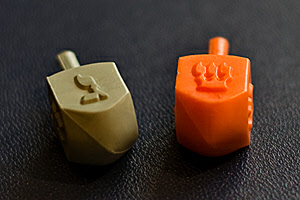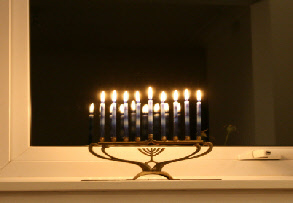ICJudaism: A Teacher’s Guide to Judaism
Hosted by ICTeachers Formerly: Mike’s Rough Guide to Judaism
Disclaimer:
The contents of these pages represent the author’s personal views, experience and
understanding.
There are bound to be some things here that some Jews would disagree
with.
Chanukah (it has a variety of different spellings when transliterated into English) falls in December. In religious terms it is a minor festival and commemorates the rededication of the Temple in Jerusalem after the successful (for the Jews) revolt of the Maccabees, a leading Jewish family in Judea who led a revolt against the occupying Seleucid Empire in around 165 BCE. During the occupation the Temple had been desecrated by the installation of a statue of Zeus, and Jewish practice had been prohibited on pain of death.
One particular key feature of the Temple was the Menorah, a 7-
Chanukah is celebrated by the lighting of candles in an 8-
As we light the candles we say two blessings (Jews say blessings for just about anything and everything). The blessings are said in Hebrew and translate as:
Blessed are you Lord our God, King of the Universe, who makes us holy through doing His commands, and commands us to kindle the lights of Chanukah.
and
Blessed are you Lord our God, King of the Universe, who did wonders for our fathers in those days, at this season.
On the first night, when lighting the first candle, we say an extra blessing :
Blessed are you Lord our God, King of the Universe, who has kept us alive, supported us and brought us to this season.
(This same blessing is said on the first day of every festival and also on other special firsts such as tasting the first fruits of the harvest, moving into a new home or putting on new clothes).
Chanukah is a fun time. It is traditional to give children presents of money (Yiddish:
Chanukah gelt) and to eat foods that have been cooked with oil, such as doughnuts
and potato latkes (pronounced lut’k’z). Latkes are deep-
There is also a simple game of chance called Dreidel (pron. Drayd’l) that children
like to play. Sweets or other nibbles such as raisins are bet on the fall of a 4-
Chanukah

If the dreidel falls with Gimel uppermost then the player wins the whole pot;
If Hay is showing the player wins half the pot;
Shin means put another sweet into the pot;
Nun means win nothing, lose nothing.
Dreidels showing 2 of the four letters (gimel and shin). Dreidels are often much more ornate than these.

There is no fixed design for a chanukiah. They come in all sorts of shapes, sizes and designs. However, the 8 celebratory candles must be at the same height and the servant candle is at a different level or in a different plane. In this one the servant candle is in the centre and slightly higher than the others.
It is traditional for a chanukiah to be placed in a window so that itis visible to passers by as well as people in the house.
When the kitty is empty, everyone puts another sweet in to keep the game going.
Chanukah does not require Shabbat-
